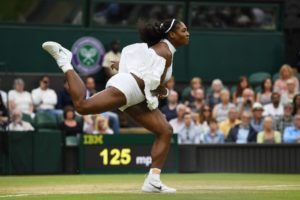Wimbledon Grass or U.S. Open Hard Court? They Are Now One And The Same
Whether it’s the Wimbledon grass or the U.S. Open hard courts, the rallies in the men’s game are basically the same.
An analysis of IBM statistics of the past four tennis majors shows that there is almost no difference in the way the points are constructed in the men’s draws at Wimbledon and the U.S. Open. And contrary to popular belief, women now play shorter points than men.

Roger Federer, seen here during last year’s Wimbledon finals against Novak Djokovic, started off playing serve-and-volley but became an aggressive baseliner as the speeds of the courts changed. (Photo: Julian Finney/Getty Images)
“A grass-court is now essentially a hard court,” Craig O’Shannessy, the strategy analyst for Wimbledon, the Australian Open and the men’s and women’s Tours, said in an interview at the All England Club. “We have this romantic, historic idea of what grass-court tennis is. We need to throw that out the window.”
Here’s a look at the length of the rallies played in the men’s singles draws at the past four majors:
“These numbers at Wimbledon show us that there is almost no difference with how a hard-court point is constructed and how a grass-court point is constructed,” in the men’s game, O’Shannessy said.
“It looks different and it feels different, and yes you’ve got to move a little differently but the structure of the point is identical,” he said.
Perhaps surprisingly, there is now a bigger gap between grass and hard court tennis in the women’s game than there is in the men’s. In other words, women get more value for attacking shots on the low-bouncing grass.
At Wimbledon, 68% of all rallies in the women’s draw in the first week (not counting the Middle Sunday) were won in the 0-4 shot range, compared to 66% at the U.S. Open and 64% on the clay of Roland Garros.
“The gap is a little bit bigger in the women because the surface plays out more,” O’Shannessy said. “That’s because the average speed of the first serve is not as dominant so the surface has a little bit more impact.

Defending champion Serena Williams during her fourth-round win over Svetlana Kuznetsova on Monday. Grass is still the perfect surface for the aggressive game style of Williams, in possession of what John McEnroe once called “the best serve in tennis.” (Photo: Shaun Botterill/Getty Images)
“These numbers show that the grass is helping the women out a little bit more than it is the men. It gives the women a bit more assistance.”
Wimbledon is the only Grand Slam event where players still compete on the game’s original surface. In 2000, the All England Club changed its grass seed mix to 100% perennial ryegrass, from a mixture of 70% rye and 30% creeping red fescue before.
Court preparation has also helped smooth out any differences.
“The bad bounces are gone, the courts are now so level, the preparation of the grass-court is so immaculate that it is now behaving exactly like a hard court,” O’Shannessy said.
Pete Sampras, seen here beating Boris Becker in the 1995 Wimbledon finals, won seven championships at the All England Club playing serve-and-volley. (Photo: Clive Brunskill/ALLSPORT)
The change had a big impact on the game. Having been mostly dominated by serve-and-volley players such as Boris Becker, Stefan Edberg and Pete Sampras in the 1980s and 1990s, Wimbledon has been won mainly from the back of the court since then by the likes of Rafael Nadal, Roger Federer and Novak Djokovic.
When Federer won the first of a men’s record seven Wimbledon championships in 2003, he played serve-and-volley on 48% of his service points. By 2012, when he won his seventh title, that percentage had dropped to 9%, according to the book “Fedegraphica. A graphic biography of the genius of Roger Federer,” by Mark Hodgkinson.
Federer, who in recent years has become a more aggressive player again, would like to see bigger differences in court speed.
“Some variety would be nice, some really slow stuff and then some really fast stuff, instead of trying to make everything sort of the same,” the Swiss said at the ATP World Tour finals in 2012. “You sort of protect the top guys really by doing that because you have the best possible chance to have them in the semis at this point. But should that be the goal? I’m not sure.”
Given the homogenization of court surfaces, it is perhaps not surprising all four majors until Wimbledon 2016 were all won by the same player, the top-ranked Djokovic.
“He’s winning everything because all the courts are the same,” O’Shannessy said, speaking before the Serb’s shock exit to Sam Querrey in the third round.
Competing in his first ever main draw grand slam match on grass, French qualifier Albano Olivetti rushed to the net 107 times, struck 108 winners including 56 aces, yet still lost.
“It’s the first time I played well on grass, and I had this feeling that my serve is the same,” Olivetti said in an interview after losing in five sets to Australia’s Matthew Barton.
“Everybody always says that the grass is very fast with your serve and everything,” said Olivetti. “And finally when I played on grass, I was a little disappointed. I think it is the same for the speed of the ball, grass and hard. The only difference is the ball stays low on the grass.”
“The movement is different, you’re going to slide more on clay and grass is going to stay a bit lower, and hard will bounce up a bit more but it’s certainly come together,” O’Shannessy said. “Clay used to be much slower, grass used to be much faster. So there used to be more of a spread.”
Article written by Danielle Rossign of Forbes.
0


